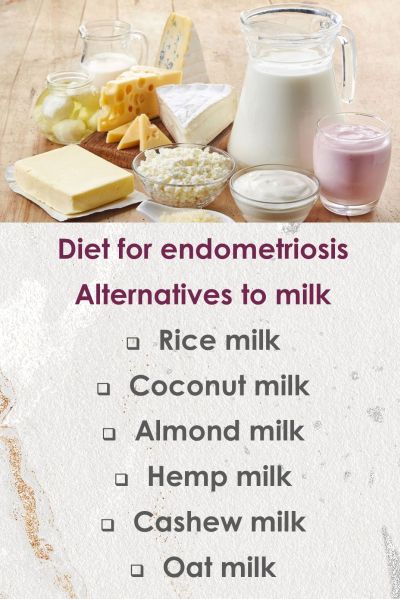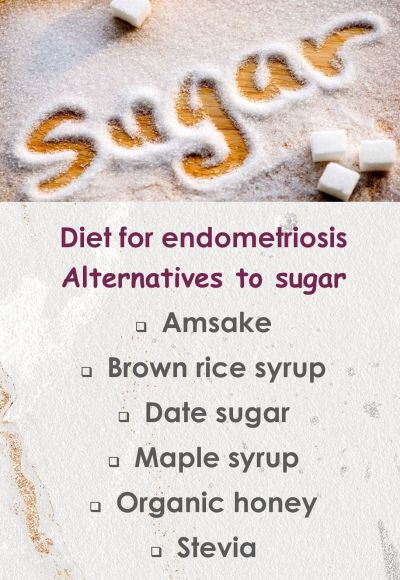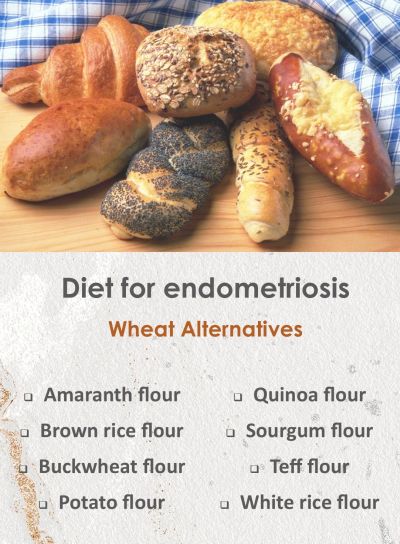Alternative food ingredients to help endometriosis

A compilation of "endo-friendly" alternatives for some of the basic ingredients....
Milk, wheat and sugar – these three foods or ingredients are really common in the everyday Western diet and probably seem the most difficult to adapt when wanting to change your eating habits to help with endometriosis. Sugar and dairy is advised to be omitted from your diet as these foods cause inflammation and can make the symptoms of endometriosis worse. They also seem to be responsible for causing endo belly for many. Let's face it, sugar is just really negative food - zero nutrition and too much increases the risk of diabetes, not to mention weight gain!
It is also advised to replace wheat with alternative grains, as there are compounds in modern wheat called phytic acid, and this compound seems to be a problem for those with endometriosis. Additionally, changing from wheat to a gluten free diet has helped many by reducing their pain and inflammation. Additionally, gluten is really bad news for those with auto-immune issues like Coeliac disease and those with Hashimoto's hypothyroidism can benefit from stopping gluten as this can help to reduce the auto-immune anti-bodies,
Fortunately, there are plenty of alternatives available, and many of these optional ingredients are becoming easier to find, not only in health food stores, but in the big supermarkets as well (they don't like to miss out on a bit of profit!)
Below is a list of options or alternatives for each of these foods.

Milk substitutes
'Going gluten-free, dairy-free, soy-free, refined sugar free, and avoiding all meat except fish has helped me a ton! Sometimes it’s hard picking out what to eat but as long as I stick to my fruits, veggies and salmon then I feel so much better.'
Milk is a very common ingredient in certain recipes, especially sauces and desserts, but in fact almost any liquid can be used as a substitute. Water, nut and seed milks, fruit juice, or rice milk can be used depending on the recipe. If you want richness, nut milks, coconut milk or rice milk is a better option.
Fruit juice adds sweetness, and rice milk has its own sweetness. Nut and seed milks are very good on cereal, made into healthy milk shakes, or used for cooking in recipes. All have no cholesterol, are low in saturated fat and some are even low in total fat.
You can also purchase substitute milk made from soy, but soy is advised to be excluded in your diet when you have endometriosis as it is has high levels of phyto-estrogens. Soy can also impair the absorption of key nutrients.
Nut and seed milks are also very good in creamy soups, sauces, puddings and ice cream, where the extra richness really makes them special. Rice and almond milk is available at natural food stores. Both of these milks taste quite good. They tend to be on the sweet side, but are fine to be used as a substitute in cooking, for drinking, or on cereals.
Coconut milk is another option and is readily available in supermarkets. It is one ingredient that is commonly used in Asian cooking and has a lovely creamy taste, which makes it ideal to use in desserts.
Just a word of caution about coconut milk:
You need to be cautious and ensure you are not buying coconut milk that has additives and one in particular to be aware of is carrageenan as it has been found to cause inflammation.
Researchers have found that carrageenan can trigger an inflammatory response in the body due to its unique chemical structure. Carrageenan helps to thicken the milk and give it a good texture, and it is also used to prevent the separation of the liquids within the milk. If you are unable to find coconut milk with carrageenan, you can mix coconut cream with water to make your own coconut milk.
Alternatives to milk for everyday use
The common alternatives to cow’s milk you can find in health stores include:
- Almond milk
- Rice milk
- Coconut milk
- Cashew milk
- Oat milk
Health Tip from Dr Marilyn Glenville regarding dairy and red meat with endometriosis
Eliminating these foods will improve endometriosis symptoms
‘Dairy and red meat contain ‘arachidonic acid’, which encourages the production of hormone-like substances called prostaglandins. The particular prostaglandin produced is highly inflammatory, and can cause swelling, pain and in some cases, thicken the blood itself. It can also trigger muscle contraction and constriction of the blood vessels, which can increase period pains, endometriosis-related cramps and the spread of endometrial tissue. The high saturated fat content of both dairy and red meat is also a factor in producing more oestrogen.’
‘You may be concerned that a diet low in dairy produce will be deficient in calcium, but don’t worry; there are many other equally good, and indeed better, sources of calcium in foods such as broccoli, green leafy vegetables, seafood, almonds, asparagus, oats and sesame seeds, to name just a few. Most decent vitamin and mineral supplements contain good levels of calcium and other important nutrients for your bones.’

Varieties of Alternative Sweeteners
'I was abusing sugar for decades. I stopped about six months ago. Since then, pain! I thought something must be really wrong until my clever Mum noted this was just my body healing itself after years of sugar trauma.'
Following an eating plan to help endometriosis, one of the ingredients to cut down to a minimum is sugar due to it causing inflammation. Also the regime for a diet to combat Candida is to eliminate sugar intake totally.
There is far too much sugar in the average Western diet and it can be found in surprising places in convenience foods. Table sugar is usually made from beets, corn, or cane (a relative of wheat), or a blend of all three.
Following a healthy diet to eliminate sugar seems difficult if you want to include sweets/puddings, baking, and cakes in your diet, or you prefer sweetener in your drinks.
There are fortunately other alternatives that do not have the same inflammatory ill-health effects as sugar. If you shop at natural food stores, you will find a wide variety of natural sweeteners. Under no circumstances should you replace sugar with artificial sweeteners – they are exceedingly toxic.
When baking cookies, muffins, and cakes, try adding fruit juice, dates, bananas, or fruit puree to replace the sweetness required in your recipe. In fact adding bananas is really effective to sweeten baking recipes.
- Aspartame - (NutriSweet) – Don’t use this one. I have included this information here as a warning. Aspartame forms methanol and formaldehyde in the body and can cause numerous side effects. Saccharin sweeteners are weak carcinogens. Fructose, used comprehensively in convenience foods, is not made from fruit, as you might suppose, but it is a highly refined product made from table sugar and may contain corn.
- Amasake - Amasake is a traditional Japanese product made by fermenting sweet brown rice into a thick liquid. It is a creamy, quickly digested beverage used by athletes after a workout or as a sweetener in cooking or baking
- Brown rice syrup - Brown rice syrup is a naturally processed sweetener, made from sprouted brown rice. It is thick and mild-flavoured.
- Date sugar - can be used on those occasions when you need a dry sugar. It is made from ground dates and is usually available from natural food stores. Try it in your crumble mix for fruit crumbles.
- Fruit juice concentrates - Fruit juice concentrates are made by cooking down various fruits, grape, and pear juices to produce a sweeter, more concentrated product. The product is then frozen to increase shelf life.
- Honey - is often suggested in many recipes, but honey is another food that should not be used by women with endometriosis unless they can be sure that the honey they purchase is certified organic honey.
- Note re Honey - You need to be aware of not buying contaminated imported honey, which can be diluted or contaminated with antibiotics and other chemicals. Also it has been found that some honey is obtained from bees that are using pollen from GM crops to produce honey. And finally, honey can be filtered so much during processing that there is no beneficial pollen left in the honey, thus leaving it with no nutritional value.
- Maple syrup - and rice syrup can be used the same way as you would use honey in your diet. Maple syrup contains fewer calories and a higher concentration of minerals than honey. It is available throughout the year in your local supermarket. Get the best quality you can.
- Stevia - is another great sugar alternative and is now being sold in many supermarkets and health shops. It is a plant which is native to Paraguay. Stevia is 30 times sweeter than sugar. Studies have found the leaf to contain proteins, fibre, carbohydrates, iron, phosphorus, calcium, potassium, sodium, magnesium, zinc, rutin (a flavonoid), true vitamin A, Vitamin C and an oil which contains 53 other constituents. Do not purchase Stevia from the supermarket as this is usually a poor quality product, and it is better to purchase from your local health store.
Download the Shopping list for the endometriosis diet

Alternatives to Wheat Flour
Many grains can be used to replace wheat. I have included most of the gluten free alternative flours you can use. Listed below are other flours that you need to omit for the endometriosis diet if you wish to be gluten free or the grain is closely related to wheat.
However, some of the alternatives to wheat flour can be used in small amounts, especially if they are mixed with other flours.
'I went gluten free and it got rid of all the IBS type symptoms, it was a miracle the difference it made in my life. I never had any issue with gluten prior to my endo diagnosis.'
Here is a list of flours and their properties:
Amaranth flour - Gluten free - Unrelated to wheat - Amaranth flour is made from the seed of the Amaranth plant, which is a leafy vegetable. Amaranth seeds are very high in protein, which makes it a nutritious flour for baking.
Barley flour - Small amount of gluten - Related to wheat so should be rotated - Barley only contains a small amount of gluten, so is rarely used to make bread, with the exception of unleavened bread. It has a slightly nutty flavour, and can be used to thicken or flavour soups or stews. Blended with other alternative flours it is also fairly versatile for cakes, biscuits, pastry, dumplings etc.
Brown rice flour - Gluten free - Related to wheat so should be rotated - Brown rice flour is heavier than its relative, white rice flour. It is milled from unpolished brown rice so it has a higher nutritional value than white, and as it contains the bran of the brown rice it has higher fibre content. This also means that it has a noticeable texture, a bit grainy.
Buckwheat flour - Gluten free - Unrelated to wheat - It does have a slight nutty taste, which will sometimes come out in recipes depending on the other ingredients, and the texture will also contribute to a heavier product than recipes made with white rice flour. It is not often used completely on its own because of its heavier nature. Bulk buying is not recommended as it is better used when fresh, store in an airtight container.
Corn-flour - Gluten free - is milled from corn into a fine, white powder, and is used for thickening recipes and sauces. It has a bland taste, and therefore is used in conjunction with other ingredients that will impart flavour to the recipe. It also works very well when mixed with other flours, for example when making fine batters for tempura. Some types of corn-flour are milled from wheat but are labelled wheaten corn-flour. Alternative name: corn-starch.
Chickpea flour - Gluten free - Unrelated to wheat - This is ground from chick peas and has a strong slightly nutty taste. It is not generally used on its own. Nutritious but expensive
Millet flour - Gluten free - Related to wheat so should be rotated - Comes from the grass family, and is used as a cereal in many African and Asian countries. It can be used to thicken soups and make flat breads and griddle cakes. Because it lacks any form of gluten it's not suited to many types of baking.
Oat flour - Small amount of gluten - Ground from oats. Care also needs to be taken to ensure that it is sourced from a non-wheat contaminating process.
Potato flour - Gluten free - This flour should not be confused with potato starch flour. Potato flour has a strong potato flavour and is a heavy flour so a little goes a long way. Bulk buying is not recommended unless you are using it on a very regular basis for a variety of recipes as it does not have a very long shelf life.
Quinoa flour - Gluten free - Unrelated to wheat - Quinoa is related to the plant family of spinach and beets. It has been used for over 5,000 years as a cereal, and the Incas called it the mother seed. Quinoa provides a good source of vegetable protein and it is the seeds of the quinoa plant that are ground to make flour.
Rye flour - Contains small amount of gluten - Closely related to wheat so not suitable for endometriosis diet - Rye flour is a strongly flavoured flour, dark in colour.
Sorghum flour - Gluten free - Not related to wheat - Ground from sorghum grain, which is similar to millet. The flour is used to make porridge or flat unleavened breads. It is an important staple in Africa and India. This flour stores well under normal temperatures. However, due to the stress this plant can undergo during growing by high temperatures and drought it can contain toxic levels of cyanide and/or nitrates at later stages in growth, therefore it is not a sources of flour I would recommend.
Spelt flour - Related to wheat so not advised for the endometriosis diet
Teff flour - Gluten free - Distantly related to wheat so fine for the endometriosis diet - Teff comes from the grass family, and is a tiny cereal grain native to northern Africa. It is ground into flour and used to prepare injera, which is a spongy, slightly sour flat bread. It is now finding a niche in the health food market because it is very nutritious.
White rice flour - Gluten free - This flour is milled from polished white rice so it is very bland in taste, and not particularly nutritious. White rice flour is ideal for recipes that require a light texture, for example herb dumplings. It can be used on its own for a variety of recipes and has a reasonable shelf life, as long as it is stored in an airtight container to avoid it absorbing moisture from the air.

About the Author
Hi, I am Carolyn Levett, the Founder here at endo-resolved - I am an Integrative Health Coach having studied nutrition, naturopathy and aromatherapy as well as being a published author of three endometriosis books. I used to suffer from severe endometriosis and was fortunate to be able to regained my health and recover from this disease with the support of nutrition, natural therapies and lots of determination.
My motivation is to help other women with endometriosis to heal their bodies so they may start to overcome this awful disease without having to totally rely on toxic drugs and surgeries which can cause further damage - with healing thoughts, Carolyn.
Reference:
https://pubmed.ncbi.nlm.nih.gov/15051604/
https://www.health.harvard.edu/staying-healthy/foods-that-fight-inflammation
https://pubmed.ncbi.nlm.nih.gov/15254009/
https://pubmed.ncbi.nlm.nih.gov/22003899/
https://bloominuterus.com/2015/04/06/why-no-dairy/
http://endometriosis.org/resources/articles/dietary-modification/
 As featured in:
As featured in:




